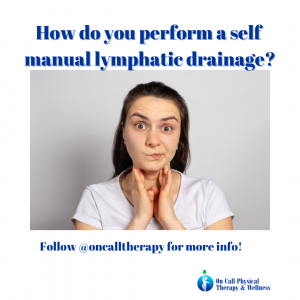
One of the leading causes of Lymphedema (also known as lymphatic obstruction) is a buildup of excess fluid inside one’s tissue (edema). To maintain a healthy immune system, a healthy lymphatic system is a need. The lymphatic system is responsible for transporting a fluid called lymph. It’s common for Lymphedema to occur from a blockage in this system.
Patients with Lymphedema in one or more of their extremities are more prone to develop it elsewhere. In infrequent circumstances, both arms and legs may be affected. Some people have Lymphedema in the genitals, face, head, neck areas.
Treatment for Lymphedema
- It is recommended that you consult with a certified lymphedema therapist (CLT) about your lymphedema to develop an appropriate plan of care to address your lymphedema. Treatment usually involves complete decongestive therapy, which includes compression, skin care, self-care education, manual lymph drainage, multi-layer bandaging and exercise.
SELF MANUAL LYMPHATIC DRAINAGE
Clearing motions can be repeated as many as 10 times a day. It is recommended to always massage both sides of your body, not just the side with the lymphedema.
To clear the supraclavicular area:
Begin by lying on a comfortable, flat surface.
Cross your arms on your chest, with your hands resting just below the collarbones.
Then lift your elbows slowly. The muscle action is as much pressure required to prepare the area to flush lymphatic fluid.
Clear the axillary area:
Lay one hand above your head.
Use your other hand to gently scoop the underarm area from top to bottom. The only pressure required is gentle enough to move the surface of the skin.
Finally, clear the area inside the elbows:
Lay your arm straight at your side.
Use the fingers of your opposite hand to gently pull the skin inside the elbow an inch at a time.
Only very gentle pressure is required.
“In lymphatic massage, you’re only working the superficial skin structure,” says Patel. That’s where the fluid is trapped.
How to perform lymphatic massage on the legs?
The goal of lymphatic massage on the legs is to open the lymphatic vessels to let excess fluid drain back up into the lymph nodes located in the groin.
There are different techniques used to perform lymphatic massage on the legs, but all have the same end goal: to release the fluid to go back up through the lymph nodes.
To perform a lymphatic massage on the legs, you can follow these steps:
Perform lymphatic massage of the upper body before beginning with the legs. Follow the three stages of clearing in the supraclavicular area, the axillary area, and the inner-elbow area, in that order. This ensures that the system is clear to allow fluid to drain up.
Use light pressure. If you can feel the muscles underneath your skin, you are pressing too hard.
Begin the leg massage at the furthest point away from the injury or affected area and work your way down. For example, if your ankle has swelling, start the massage on the upper part of the leg.
Starting at the top of the leg, put one hand on the inside of the leg and the other on the back of your leg.
With gentle pressure, stretch the skin from the inside of your leg up and out, toward your hip.
Continue this motion down the leg until you reach the knee.
When you reach the knee, stretch the skin up, with alternating hands, toward your armpit.
Repeat 10 to 15 times.
You have now completed the clearing step of the lymphatic massage.
If you need a free consultation with one of our certified lymphedema therapists, reach out to us to schedule today.